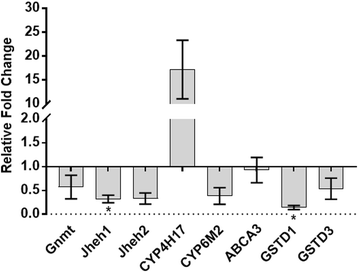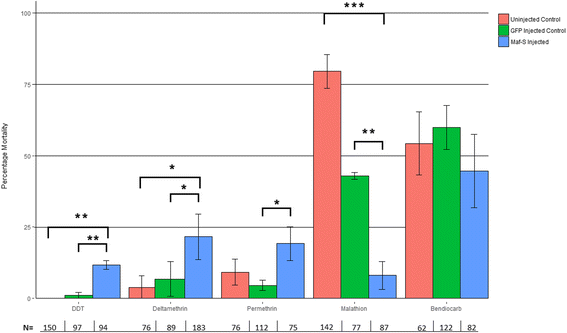The transcription factor Maf-S regulates metabolic resistance to insecticides in the malaria vector Anopheles gambiae
- PMID: 28854876
- PMCID: PMC5577768
- DOI: 10.1186/s12864-017-4086-7
The transcription factor Maf-S regulates metabolic resistance to insecticides in the malaria vector Anopheles gambiae
Abstract
Background: Malaria control in Africa is dependent upon the use insecticides but intensive use of a limited number of chemicals has led to resistance in mosquito populations. Increased production of enzymes that detoxify insecticides is one of the most potent resistance mechanisms. Several metabolic enzymes have been implicated in insecticide resistance but the processes controlling their expression have remained largely elusive.
Results: Here, we show that the transcription factor Maf-S regulates expression of multiple detoxification genes, including the key insecticide metabolisers CYP6M2 and GSTD1 in the African malaria vector Anopheles gambiae. Attenuation of this transcription factor through RNAi induced knockdown reduced transcript levels of these effectors and significantly increased mortality after exposure to the pyrethroid insecticides and DDT (permethrin: 9.2% to 19.2% (p = 0.015), deltamethrin: 3.9% to 21.6% (p = 0.036) and DDT: 1% to 11.7% (p = <0.01), whilst dramatically decreasing mortality induced by the organophosphate malathion (79.6% to 8.0% (p = <0.01)). Additional genes regulated by Maf-S were also identified providing new insight into the role of this transcription factor in insects.
Conclusion: Maf-S is a key regulator of detoxification genes in Anopheles mosquitoes. Disrupting this transcription factor has opposing effects on the mosquito's response to different insecticide classes providing a mechanistic explanation to the negative cross resistance that has been reported between pyrethroids and organophosphates.
Keywords: Anopheles gambiae; Cross resistance; Insecticide resistance; Metabolic resistance; Mosquito; Transcriptional control.
Conflict of interest statement
Ethics approval and consent to participate
Not Applicable.
Consent for publication
Not Applicable.
Competing interests
The authors declare that they have no competing interests.
Publisher’s Note
Springer Nature remains neutral with regard to jurisdictional claims in published maps and institutional affiliations.
Figures



Similar articles
-
Malaria vectors in the Democratic Republic of the Congo: the mechanisms that confer insecticide resistance in Anopheles gambiae and Anopheles funestus.Malar J. 2017 Nov 7;16(1):448. doi: 10.1186/s12936-017-2099-y. Malar J. 2017. PMID: 29115954 Free PMC article.
-
Insecticide resistance status of three malaria vectors, Anopheles gambiae (s.l.), An. funestus and An. mascarensis, from the south, central and east coasts of Madagascar.Parasit Vectors. 2017 Aug 23;10(1):396. doi: 10.1186/s13071-017-2336-9. Parasit Vectors. 2017. PMID: 28835269 Free PMC article.
-
Identification and validation of a gene causing cross-resistance between insecticide classes in Anopheles gambiae from Ghana.Proc Natl Acad Sci U S A. 2012 Apr 17;109(16):6147-52. doi: 10.1073/pnas.1203452109. Epub 2012 Mar 28. Proc Natl Acad Sci U S A. 2012. PMID: 22460795 Free PMC article.
-
kdr: can a single mutation produce an entire insecticide resistance phenotype?Trans R Soc Trop Med Hyg. 2008 Jun;102(6):524-5. doi: 10.1016/j.trstmh.2008.01.001. Epub 2008 Mar 4. Trans R Soc Trop Med Hyg. 2008. PMID: 18295809 Review.
-
Molecular systematics and insecticide resistance in the major African malaria vector Anopheles funestus.Annu Rev Entomol. 2013;58:393-412. doi: 10.1146/annurev-ento-120811-153628. Annu Rev Entomol. 2013. PMID: 23317045 Review.
Cited by
-
Enthralling genetic regulatory mechanisms meddling insecticide resistance development in insects: role of transcriptional and post-transcriptional events.Front Mol Biosci. 2023 Sep 6;10:1257859. doi: 10.3389/fmolb.2023.1257859. eCollection 2023. Front Mol Biosci. 2023. PMID: 37745689 Free PMC article. Review.
-
Transcriptomic analysis reveals pronounced changes in gene expression due to sub-lethal pyrethroid exposure and ageing in insecticide resistance Anopheles coluzzii.BMC Genomics. 2021 May 10;22(1):337. doi: 10.1186/s12864-021-07646-7. BMC Genomics. 2021. PMID: 33971808 Free PMC article.
-
Overabundance of Asaia and Serratia Bacteria Is Associated with Deltamethrin Insecticide Susceptibility in Anopheles coluzzii from Agboville, Côte d'Ivoire.Microbiol Spectr. 2021 Oct 31;9(2):e0015721. doi: 10.1128/Spectrum.00157-21. Epub 2021 Oct 20. Microbiol Spectr. 2021. PMID: 34668745 Free PMC article.
-
Transcriptomic meta-signatures identified in Anopheles gambiae populations reveal previously undetected insecticide resistance mechanisms.Nat Commun. 2018 Dec 11;9(1):5282. doi: 10.1038/s41467-018-07615-x. Nat Commun. 2018. PMID: 30538253 Free PMC article.
-
Transcriptomic analysis of resistance and short-term induction response to pyrethroids, in Anopheles coluzzii legs.BMC Genomics. 2021 Dec 13;22(1):891. doi: 10.1186/s12864-021-08205-w. BMC Genomics. 2021. PMID: 34903168 Free PMC article.
References
-
- WHO. World Malaria Report. Geneva; 2015.
-
- WHO. Global plan for insecticide resistance management in malaria vectors (GPIRM). 2012. http://www.who.int/malaria/publications/atoz/gpirm/en/. Accessed May 2012 .
MeSH terms
Substances
LinkOut - more resources
Full Text Sources
Other Literature Sources
Miscellaneous

